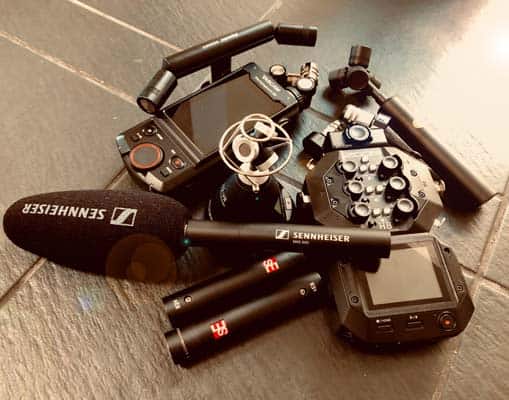Intro: How to Enhance ASMR Audio Quality
To make quality ASMR videos, you need quality audio. Some might argue that the audio is the primary trigger to tingly, relaxing, ASMR sensations.
In this post, we focus on some ways you can frame and adjust your content to bring out the ASMR triggers.
What is ASMR?
ASMR, short for Autonomous Sensory Meridian Response, is a weird phenomenon characterized by tingling sensations that often begin in the scalp and move down the spine and sometimes through the limbs.
In the early days of the internet (mid-2000s), people started making weird videos, often unknowingly, that triggered tingling sensations and relaxation in their viewers.
Who Started it?
Although the phenomenon itself had likely existed long before, it wasn’t until the rise of YouTube and online communities that ASMR became a recognized term.
The term “ASMR” was coined in 2010 by Jennifer Allen, a cybersecurity professional, who started the first ASMR Facebook group. Since then, ASMR has grown into a global online subculture, with millions of enthusiasts sharing and creating content that explores its soothing effects and diverse triggers.
ASMR is known for its relaxing and calming effects on many individuals, often aiding in stress reduction and sleep improvement.
Is there Science Behind it?
The short answer is, no, there’s no real scientific explanation yet for what this phenomenon is all about.
The longer answer is – there is sort of some science behind it.
Research suggests that ASMR activates brain regions associated with emotional processing, such as the anterior cingulate cortex and the prefrontal cortex. These activations can induce a state of relaxation and reduce stress. Additionally, ASMR may stimulate the release of endorphins and oxytocin, promoting feelings of well-being and connection.
While ASMR’s scientific exploration is ongoing, people who like ASMR find it therapeutic and helpful for managing stress and anxiety. If nothing else, it’s really weird and kind of fun.
Common ASMR Audio Triggers
ASMR tingling sensations are triggered by specific audio or visual stimuli, commonly referred to as “ASMR triggers.” Common audio triggers include:
- blowing
- whispering
- scratching
- cat purring
- humming
- clock ticking
- water sounds
- sticky sounds
- chewing
- buzzing
- crinkling
- typing
- writing
- page-turning
- tapping
These trigger sounds are highly dependent on excellent detail retrieval from the microphone recording them and the headphones playing them.
We targeted some of these triggers in our microphone test video for ASMR. Check it out below:
Ideas and Techniques to Maximise ASMR Effects Using Audio
Maximizing the ASMR (Autonomous Sensory Meridian Response) effects in audio content involves employing various techniques to enhance the sensory experience and trigger those tingling sensations and relaxation responses in listeners. Here are some key strategies:
1. Use Quality Audio Gear
You’re not going to get anywhere with the wrong tools. A cheap USB mic or headphones won’t capture or deliver the details you want. This blog is all about finding the right tools for your audio jobs. Have a look around.
See here for all of our info about audio gear and reviews.
2. Choose the Right Mic
Start with the right mic to ensure clear, crisp audio quality without background noise. You want to capture all the subtle sounds, whispers, and taps.
Most of the trigger sounds listed above occur primarily in mid to high frequencies. For this reason, small-diaphragm condenser microphones tend to work best.
Small Diaphragm Condenser Microphones
Because most ASMR triggers reside in the mid to high-frequency range, you want a mic that excels at high-frequency detail. Small diaphragm condenser microphones are the most effective mics for picking up fine, top-end detail and quick transients, making them the best choice in most cases for ASMR recording.
Large Diaphragm Condenser Microphones
Depending on the project you’re recording, sometimes large-diaphragm condensers can be the appropriate tool. Small diaphragm condensers will give you a more natural sound but large diaphragm condenser mics can be effective when you are in search of a larger-than-life sound. They also tend to have lower self-noise than small-diaphragm condensers.
For help choosing a mic for ASMR, see the following post:
2. Consider Using Ambisonic and Binaural Recording
Using ambisonic and binaural microphones simulates a 3D audio environment, immersing listeners and enhancing the sensation of sounds coming from different directions, amplifying the ASMR experience.
Nature or other outdoor ASMR experiences are ideal for 360˚ surround audio.
3. Listen with Quality Headphones
The devil is in the details! It’s as simple as this: you won’t hear the details if the cans you’re listening on have no detail retrieval. The following post is our guide to finding the best ASMR headphones:
4. Consistent Volume and Pacing
Obvious, but often forgotten advice: maintain a steady and gentle volume level throughout the recording. Sudden loud noises or abrupt changes can disrupt the relaxing atmosphere and detract from the ASMR experience.
5. Trigger Variety
Incorporate a variety of ASMR triggers such as tapping, scratching, whispering, or personal attention roleplays. Different individuals respond to different triggers, so diversity can engage a broader audience.
6. Natural Sounds
Incorporate natural ambient sounds like rain, wind, or ocean waves, which can enhance relaxation and immersion.
7. Take Time in Post-production
Skilled post-production editing can reduce background noise, improve audio clarity, and fine-tune volume levels for an optimal ASMR experience.
Use a good DAW for this. There are loads of them out there. See our post on the best DAWs for more info.
8. Scripting: Have a Plan
Carefully plan and script audio content. It can be a guided meditation to engage listeners and induce a state of relaxation or a thrilling ride where the tingles just keep tingling.
It’s good to simply have a plan. Plan a beginning, middle, and end to the experience. This might all change in post-production, but start with a plan.
9. Experiment and Seek Feedback
Just ask your audience, and they’ll let you know. Continually experiment with new techniques and seek feedback from your audience to understand what resonates most with them.
Questions or Comments?
Follow the discussion here on Facebook.

